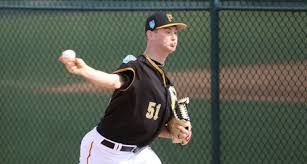Jordan Milbrath: RHP AAA - Diamondbacks
1. Could you tell us your story on dropping down?
On the last day of the 2017 spring training I was approached by the pitching coordinator for the Cleveland Indians. He informed me that I would not be breaking camp with a team, but instead I had one of two options. I could either stay in Extended Spring Training and work on throwing sidearm or take my release and go home. According to their data I was a good candidate to see if throwing from a lower slot would help my performance. I chose to take a month and try and learn how to throw sidearm. It was not an easy change at first, but I completely emerged myself in the learning process and was able to pick it up relatively quick. After a month in extended I was sent to High-A and I was able to perform well enough to finish the year in AA and be selected in the Major League Rule 5 draft that same off-season.
2. What are some of the advantages you have from your arm angle?
The main advantage from dropping down to my current arm angle is two-fold. The first and most important thing is that it is my natural arm slot when my head is in-line to home plate when I throw. When I am not pulling my head off pitches I am able to better locate my pitches and have better movement. The movement is my second advantage. Both my fastball and slider efficiency went way up when I switched angles, thus performing better and getting more hitters out.
3. If you didn't drop down, do you think you would have had the same success?
If I hadn’t been forced to drop down I have no doubt in my mind that my career would be over. Of course I wish I would have been taught to pitch like this since I was young, but God always has perfect timing and for me that was at the end of spring training in 2017.
4. What would you tell someone debating on changing their arm angle?
I have come to learn that no matter where your arm slot is, your head should always be on a line to home plate, and that slot can be different for everyone. If you are debating on switching make sure the change will allow you to A) better locate your pitches and B) make you stuff harder to hit.
5. Are there any mechanical tips that you'd give to someone throwing sidearm/submarine?
As I have already touched on, keeping the pitcher’s head on a line to home plate is most important for me. Secondly, stay as naturally athletic as possible. That means being fluid with your arm and letting it work the way it naturally wants to.
6. What pitches do you throw?
I throw a Fastball, Slider, and Changeup. The velocity on my Fastball (Sinker) averages around 95 mph. I have touched as high as 99 during the 2017 season. My slider is around 84 mph, and my Changeup averages 87.
7. How do you pitch to lefties/righties?
As a right-handed low slot pitcher, right handed hitters will always be easier for me to get out. I like to work sinkers in on righties and sliders when I am ahead to strike them out. I like to work away to lefties, and mix in changeups to keep them off my fastball. I like to strike out lefties on sliders as well. I start my slider down the middle of the plate and let it work down and in.
8. What is your favorite part about pitching from down there?
My favorite part of throwing from a lower slot is the number of groundballs I get. It makes me feel like I always have a chance to get out of the inning no matter the situation. I just need to trust my stuff and let it happen. After all it is just a game!





